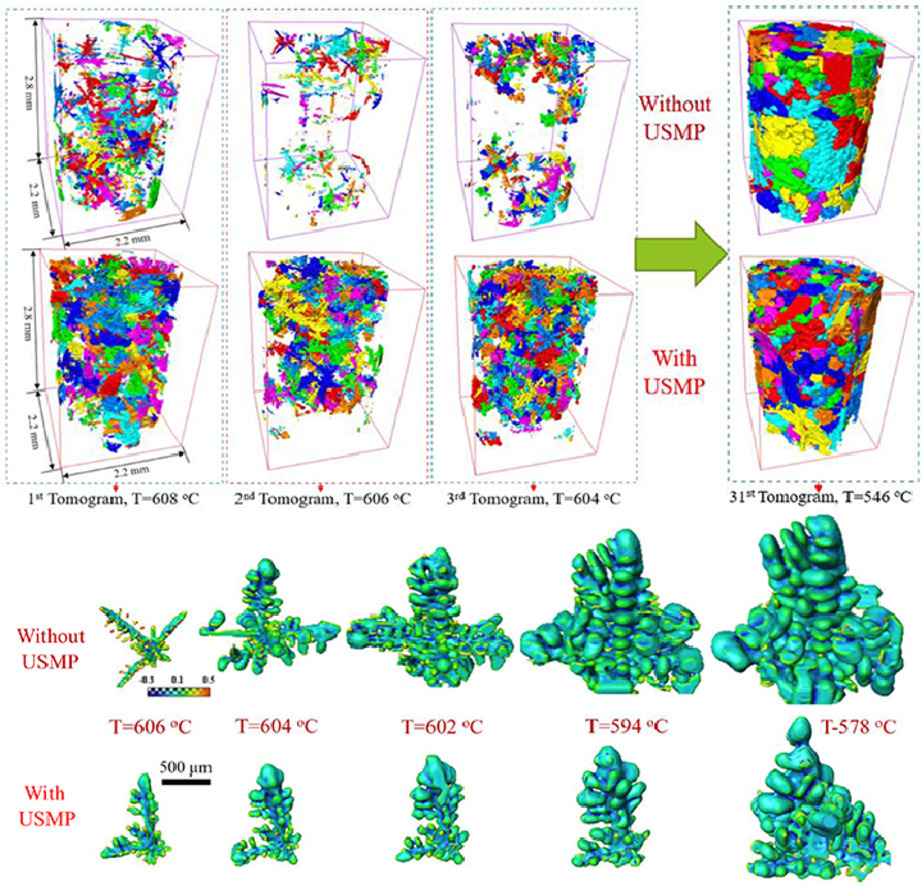金屬頂刊雙語導讀丨Acta Mater. Vol.209,1 May. 2021(下)
2021-06-20 來源:GS_Metals
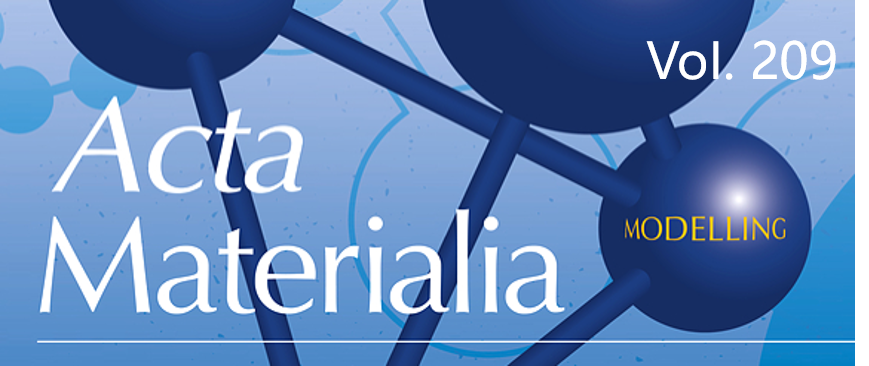
本期包含金屬材料領域論文11篇,涵蓋了鎂單晶、高熵合金、鋯合金等,國內科研單位包括哈爾濱工業大學、中科院金屬所等(通訊作者單位)。
Vol. 209 目錄
1. Effects of electric current on the plastic deformation behavior of pure copper, iron, and titanium
電流對純銅、鐵、鈦塑性變形行為的影響
2. The (110) and (320) surfaces of a Cantor alloy
Cantor合金的(110)和(320)表面表征
3. Doping distribution in Skutterudites with ultra-high filling fractions for achieving ultra-low thermal conductivity
通過調控CoSb3中的高濃度摻雜分布實現超低熱導
4. On the origin of the Hall–Petch law: A 3D-dislocation dynamics simulation investigation
通過三維位錯動力學模擬探究Hall-Petch定律的物理起源
5. Anomalous dislocation core structure in shock compressed bcc high-entropy alloys
沖擊壓縮BCC高熵合金中的特殊位錯核結構表征與研究
6. An origin of corrosion resistance changes of Zr alloys: effects of Sn and Nb on grain boundary strength of surface oxide
Sn、Nb對Zr合金表面氧化物晶界強度及Zr合金耐蝕性的影響
7. Dynamic observation of dual-beam irradiated Fe and Fe-10Cr alloys at 435?°C
435?°C雙束輻照下Fe和Fe-10Cr合金的動態觀測
8. Surprising increase in yield stress of Mg single crystal using long-period stacking ordered nanoplates
通過長周期堆垛有序結構顯著提高Mg單晶的屈服應力
9. A critical relative density and a break-and-reconnect model for annealing-induced densification in nanoporous gold
納米多孔金退火致密化的臨界相對密度和斷裂-重連模型
10. The effect of hydrogen content and yield strength on the distribution of hydrogen in steel: a diffusion coupled micromechanical FEM study
基于擴散耦合微觀力學有限元模型研究氫含量和屈服強度對鋼中氫分布的影響
11. Synchrotron X-ray imaging and ultrafast tomography in situ study of the fragmentation and growth dynamics of dendritic microstructures in solidification under ultrasound
超聲凝固過程中枝晶破碎和長大動力學的原位同步X射線成像和超快斷層掃描研究
ACTA
Vol. 209,1 May. 2021, 116776
1. Effects of electric current on the plastic deformation behavior of pure copper, iron, and titanium
電流對純銅、鐵、鈦塑性變形行為的影響
C. Rudolf?, R. Goswami, W. Kang, J. Thomas
C. Rudolf:christopher.rudolf@nrl.navy.mil
https://doi.org/10.1016/j.actamat.2021.116776
摘要
我們對多晶純銅、純鐵和純鈦試樣在不同直流電和對應純溫度條件下進行了單軸拉伸試驗。實驗過程中,樣品標距段的應變、電流密度和溫度條件保持均勻。結果表明,只在純鈦Ti樣品中發現了非熱電流效應。與無電流純溫度對比組樣品相比,材料的抗拉強度下降了20%,且晶粒生長不均勻。而在純溫度下變形或有電流無變形的試樣中,都觀察不到明顯的組織變化。電子漂流和焦耳熱效應引起的電輔助變形(EAD)機制無法解釋如此顯著的實驗現象。熱聲子導致的位錯散射和樣品徑向、軸向的熱流引起的電子運動可能是潛在的機制。以上實驗結果和熱聲子/電子散射間的可能聯系為我們研究金屬中EAD效應提供了新的思路。
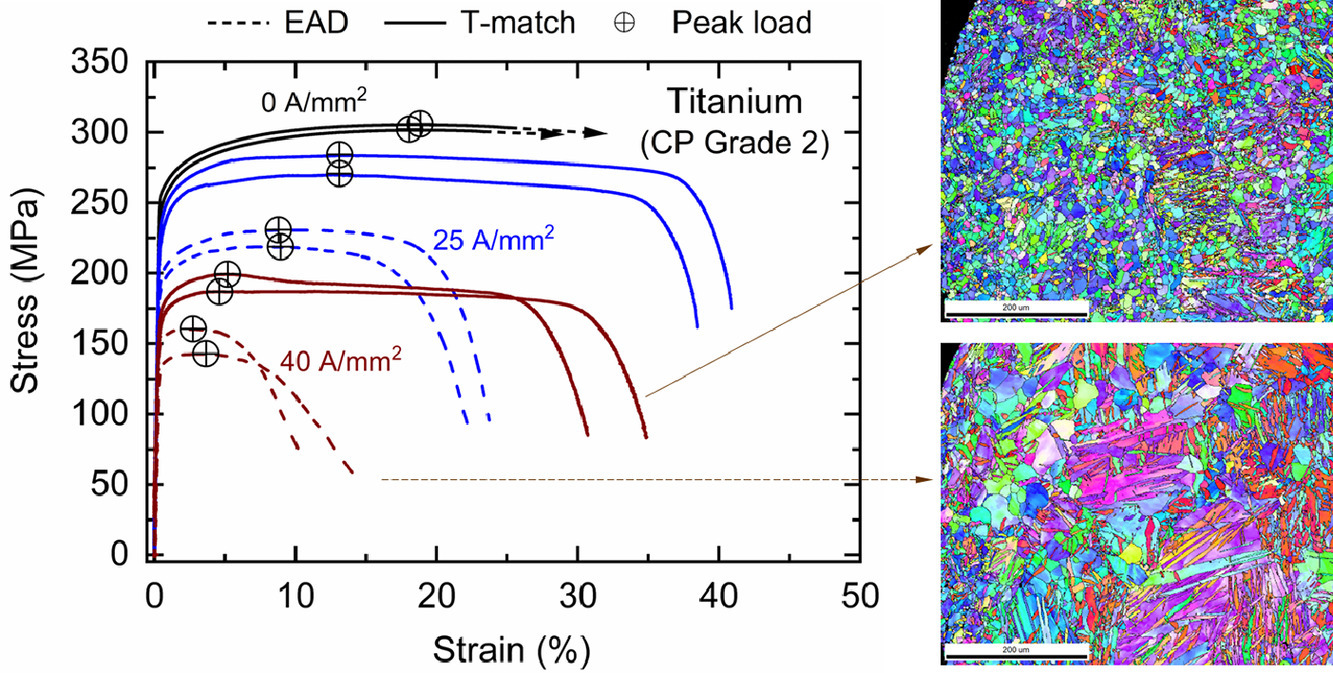
ACTA
Vol. 209,1 May. 2021, 116790
2. The (110) and (320) surfaces of a Cantor alloy
Cantor合金的(110)和(320)表面表征
J. Ledieu?, M. Feuerbacher, C. Thomas, M.-C. de Weerd, S. Šturm, M. Podlogar, J. Ghanbaja, S. Migot, M. Sicot, V. Fournée
J. Ledieu:julian.ledieu@univ-lorraine.fr
https://doi.org/10.1016/j.actamat.2021.116790
摘要
我們通過利用表面技術手段和透射電子顯微鏡(TEM)研究了單相FeCrMnNiCo固溶體的(110)和(320)表面,測定了高熵合金表面在不同濺射條件、退火溫度和退火時間下的結構和化學演化。角分辨X射線光電子能譜結果顯示,873 K時,表面存在明顯的Mn、Ni共偏聚。我們認為Mn的表面偏聚是由其較低的表面能驅動的。而Mn和Ni之間的吸引相互作用促進了Ni的偏析,并隨Mn向表面擴散。低能電子衍射和掃描隧道顯微鏡表征表明,合金的(320)表面呈階梯狀形貌的有序結構。相反,(110)表明則顯示出明顯的結構無序和局部重構。其形貌高度各向異性,且似沿[001]方向傳播。873 K以上,Mn發生脫附,Ni含量隨溫度呈線性增加。TEM分析表明,即使經過多次退火和濺射循環,高熵合金也沒有分解成金屬相或金屬間化合物。上述結果表明,存在一個上限溫度,該溫度以上,材料的表面化學計量顯著偏離五元高熵合金的概念,因此,本研究對于明確FeCrMnNiCo基涂層在航空航天等領域內的應用溫度范圍具有重要意義。
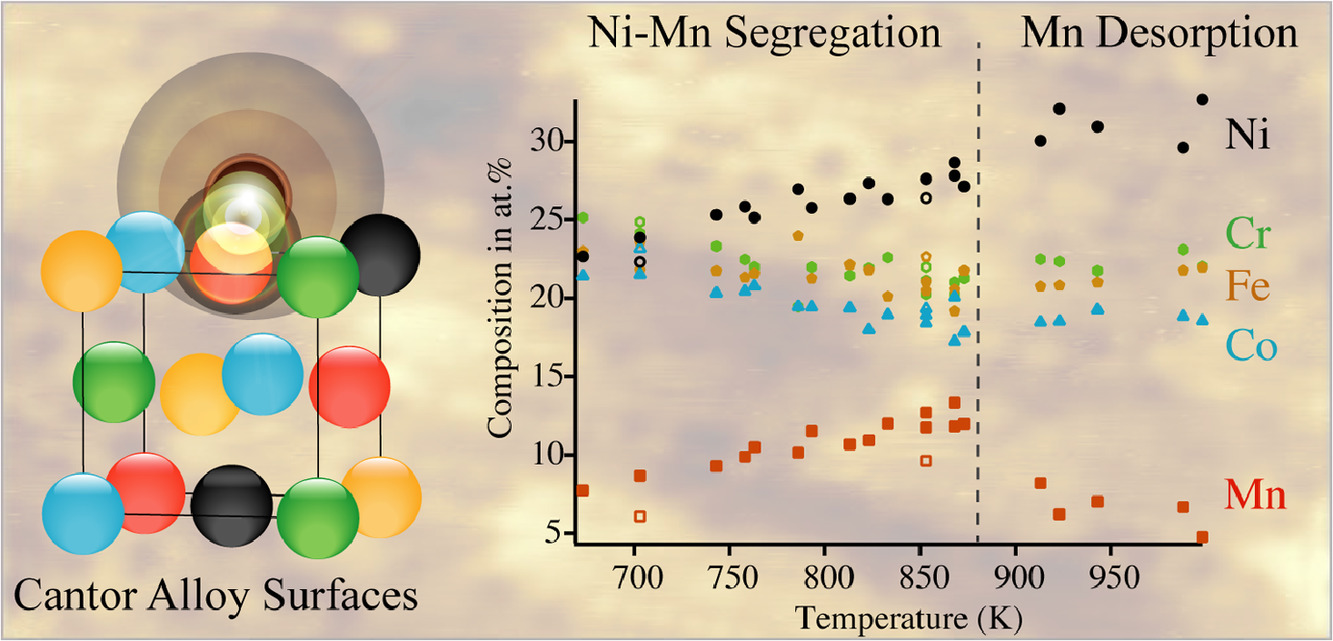
ACTA
Vol. 209,1 May. 2021, 116791
3. Doping distribution in Skutterudites with ultra-high filling fractions for achieving ultra-low thermal conductivity
通過調控CoSb3中的高濃度摻雜分布實現超低熱導
Wei Ren, Yan Sun, Jialun Zhang, Yiping Xia, Huiyuan Geng?, Lixia Zhang?
H. Geng:genghuiyuan@hit.edu.cn(哈爾濱工業大學)
L. Zhang:zhanglxia@hit.edu.cn, hitzhanglixia@163.com(哈爾濱工業大學)
https://doi.org/10.1016/j.actamat.2021.116791
摘要
熱電材料和熱障材料需要具有低晶格導熱系數。可以向基體晶格中添加間隙或置換型原子引入點缺陷,從而散射聲子,但這仍不足以實現如同玻璃般的熱傳性能。本研究中,我們制備了超高含量Yb摻雜的CoSb3結構,其中有序超結構和納米/亞納米尺度的不均勻Yb間隙原子共存。在高含量Yb摻雜、有序超結構、納米尺度的不均勻Yb填充、以及高密度晶格應變的作用下,聲子散射顯著增強,從而使得材料的晶格熱導率接近玻璃極限。以上研究為通過調控摻雜原子的分布,設計超低熱導的熱電、熱障材料提供了新的思路。
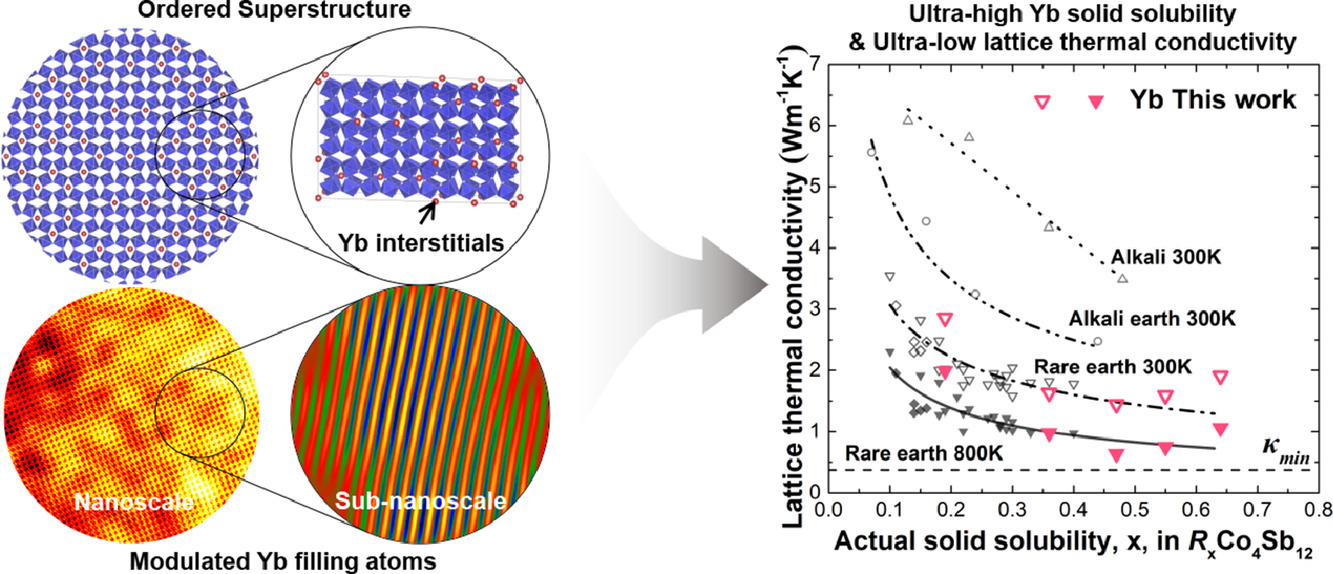
ACTA
Vol. 209,1 May. 2021, 116783
4. On the origin of the Hall–Petch law: A 3D-dislocation dynamics simulation investigation
通過三維位錯動力學模擬探究Hall-Petch定律的物理起源
Maoyuan Jiang?, Ghiath Monnet, Benoit Devincre
M. Jiang:maoyuan.jiang@gmail.com
https://doi.org/10.1016/j.actamat.2021.116783
摘要
我們對1 ~ 10µm的立方晶粒進行了三維位錯動力學(3D-DD)模擬,以探究Hall-Petch定律的物理起源。特別是,我們對晶界處累積的極化位錯密度(GNDs)引起的長程應力(背應力)、以及與森位錯密度(SSDs)相關的短程應力分別進行了區分和量化。研究表明,在低應變下,背應力和相應的應變硬化與晶粒尺寸無關。因此,在位錯動力學模擬框架下,晶粒的尺寸效應主要受隨晶粒尺寸減小而增加的CRSS控制。CRSS幅值的演化受兩種相互競爭的強化機制調控,與模擬和實驗中觀察到的Hall-Petch定律的一般形式相互印證。
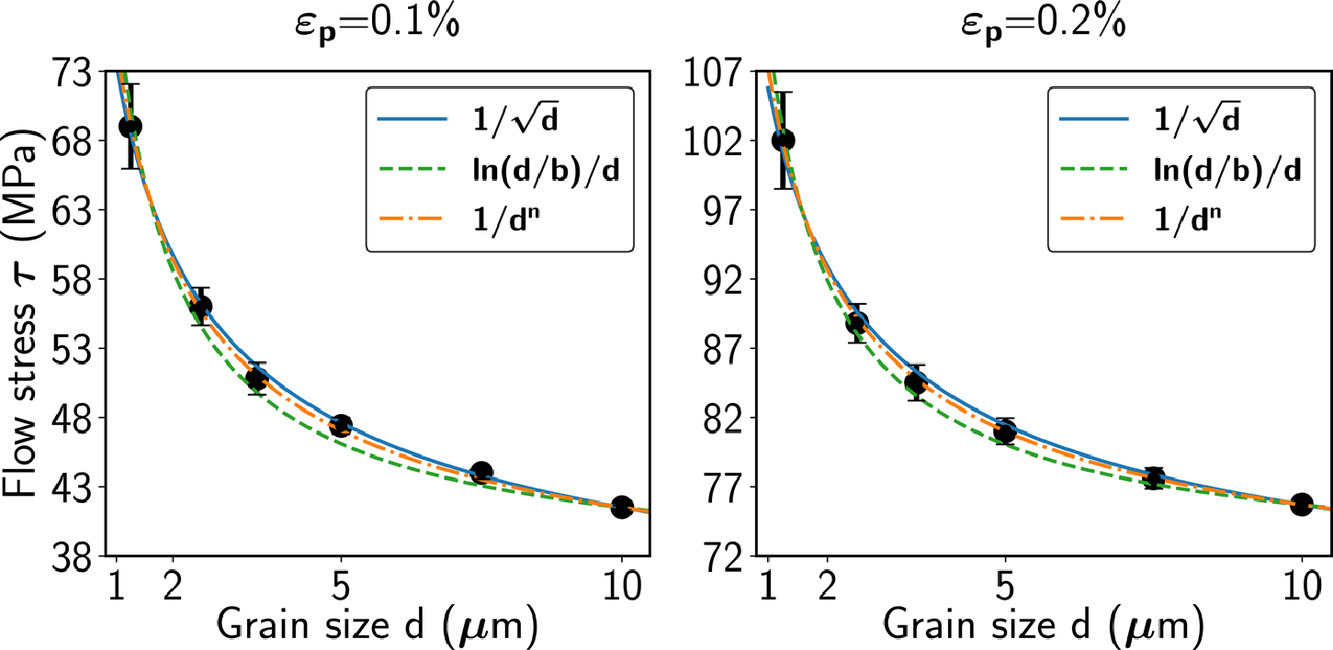
ACTA
Vol. 209,1 May. 2021, 116801
5. Anomalous dislocation core structure in shock compressed bcc high-entropy alloys
沖擊壓縮BCC高熵合金中的特殊位錯核結構表征與研究
Long Zhao, Hongxiang Zong?, Xiangdong Ding, Turab Lookman
H. Zong:zonghust@mail.xjtu.edu.cn(西安交通大學)
https://doi.org/10.1016/j.actamat.2021.116801
摘要
研究表明,在多主元合金中,由于成分/結構的不均勻性,存在特殊的位錯核結構和位錯運動模式。然而目前尚不清楚極端添條件下,多主元合金中仍存在這些現象。因為在極端條件下,固溶效應會被巨大的驅動力所抵消。本研究中,我們通過大規模分子動力學模擬,研究了BCC高熵合金(HEAs)經沖擊后的位錯結構。與BCC純金屬相比,我們在沖擊壓縮TiZrNb和NiCoFeTi 高熵合金中發現了具有高度穩定性的特殊“擴展”刃位錯結構。這種獨特的位錯結構有利于位錯的快速運動,從而抑制變形早期發生孿晶形核。結合連續介質彈性理論,我們發現“擴展”位錯結構的形成主要是由于高熵合金中納米尺度的成分非均勻性導致了低彈性穩定性的局部結構。此外,我們說明了原子間作用勢對位錯結構的影響。

ACTA
Vol. 209,1 May. 2021, 116804
6. An origin of corrosion resistance changes of Zr alloys: effects of Sn and Nb on grain boundary strength of surface oxide
Sn、Nb對Zr合金表面氧化物晶界強度及Zr合金耐蝕性的影響
Rong Yuan, Yao-Ping Xie?, Tong Li, Chen-Hao Xu, Mei-Yi Yao, Jing-Xiang Xu, Hai-Bo Guo, Bang-Xin Zhou
Y.-P. Xie:ypxie@shu.edu.cn(上海大學)
https://doi.org/10.1016/j.actamat.2021.116804
摘要
Zr合金作為核燃料包層結構材料,需要具備良好的抗腐蝕性能。幾十年來,通過調整Sn和Nb的含量,已經研制出了幾代具有優良耐腐蝕性能的Zr合金。但Sn和Nb對合金耐蝕性的影響機理尚不清楚。我們通過計算模擬,發現Sn或Nb會在氧化膜晶界(GB)處偏聚,引起晶界結合力的變化,從而影響耐蝕性。第一性原理計算表明,Sn偏聚降低晶界結合力,減弱了氧化膜的保護性;而Nb偏聚則增強晶界結合力,提高氧化膜的保護性。因此降低Sn或增加Nb可以提高Zr合金的耐蝕性。以上研究結果加深了我們關于合金元素對Zr合金耐蝕性影響的理解,為新型Zr合金的設計提供了指導。
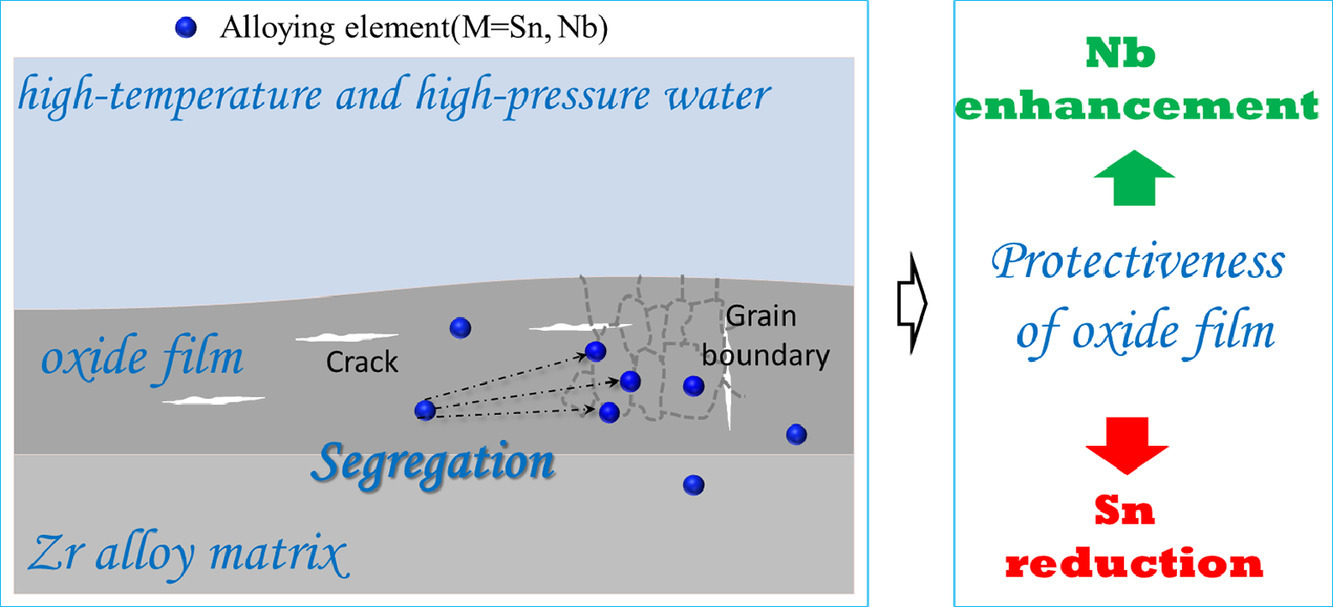
ACTA
Vol. 209,1 May. 2021, 116793
7. Dynamic observation of dual-beam irradiated Fe and Fe-10Cr alloys at 435?°C
435?°C雙束輻照下Fe和Fe- 10cr合金的動態觀測
Yan-Ru Lin?, Wei-Ying Chen?, Meimei Li?, Jean Henry?, Steven John Zinkle?
Y.-R. Lin:ylin52@vols.utk.edu
W.-Y. Chen:wychen@anl.gov
M. Li:mli@anl.gov
J. Henry:jean.henry@cea.fr
S.J. Zinkle:szinkle@utk.edu
https://doi.org/10.1016/j.actamat.2021.116793
摘要
鐵素體/馬氏體鋼具有良好的力學性能和抗輻照腫脹性能,是一種優秀的先進核反應堆備選結構材料。而輻照后Fe和Fe- Cr合金中b=½<111>和b=<100>兩種位錯環的比例一直是引起研究者興趣的一個問題。學界雖然對< 100 >位錯環的形成機制進行了大量的模擬研究,但事實上,我們對于Fe(Cr)合金的基本輻照實驗過程的理解仍不深入。我們在435?°C的雙束(1 MeV Kr?+?10 appm He/dpa)輻照下,研究了高純度Fe和Fe- 10Cr合金在0 ~ 20dpa損傷范圍內的組織演化。實驗表明,< 100 >位錯環的形成機制可能不遵循傳統理論,即由兩個½<111>環發生簡單的位錯反應形成。動態形成和演化的缺陷包括黑點、位錯環粗化、位錯環裝飾、位錯網絡和孔洞。結果表明,Cr和He能夠抑制位錯環運動。我們對各類缺陷額尺寸/密度演化、以及½<111>位錯環和< 100 >位錯環的相對比例進行了定量分析。隨著損傷的增加,½<111>位錯環逐漸占據主導。值得注意的是,< 100 >環只在純Fe中的晶界附近占據主導,而Fe-10Cr合金中則大量觀察到組成< 100 >環的納米級黑點缺陷陣列。
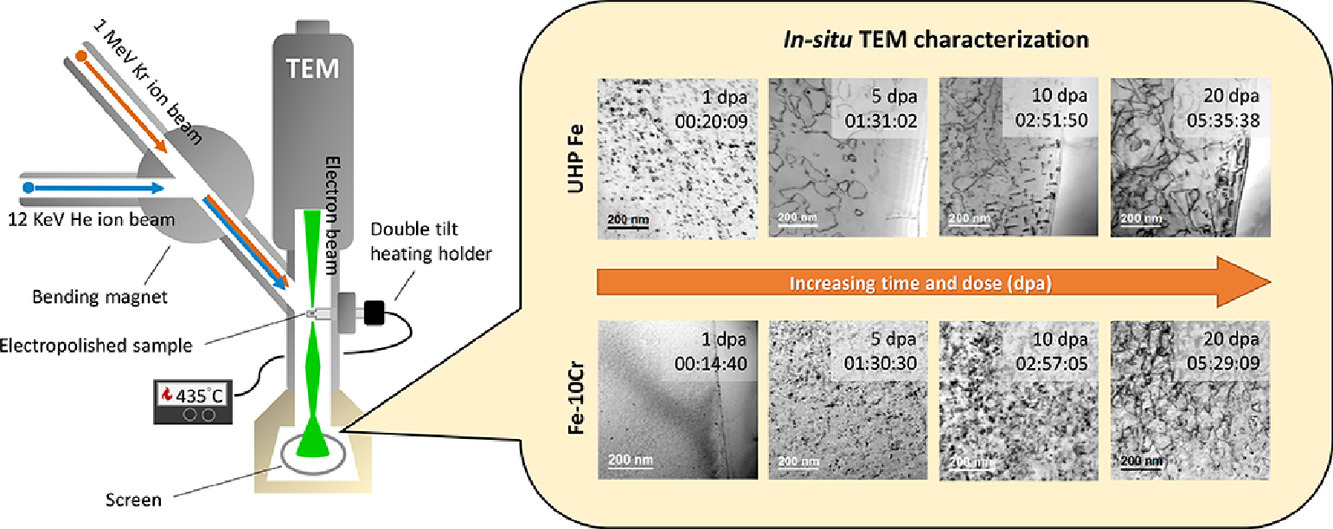
ACTA
Vol. 209,1 May. 2021, 116797
8. Surprising increase in yield stress of Mg single crystal using long-period stacking ordered nanoplates
通過長周期堆垛有序結構顯著提高Mg單晶的屈服應力
Koji Hagihara?, Ryohei Ueyama, Michiaki Yamasaki, Yoshihito Kawamura, Takayoshi Nakano
K. Hagihara:hagihara@mat.eng.osaka-u.ac.jp
https://doi.org/10.1016/j.actamat.2021.116797
摘要
具有長周期堆垛有序結構(LPSO)的Mg-Zn-Y三元合金具有優異的力學性能。一般認為LPSO相是強化相。在本研究中,我們首次發現Mg/LPSO雙相合金中基體Mg固溶體的力學性能與純Mg有顯著區別,而Mg99.2Zn0.2Y0.6單晶(基體Mg固溶體)的屈服強度與LPSO單相合金的屈服強度基本相同。這是由于組織中形成了類似層錯的缺陷,我們將其稱為“LPSO納米板”。Mg99.2Zn0.2Y0.6在變形過程中如同LPSO相一樣形成了扭結帶,從而提高了強度和塑性。因此,必須根據組織特征重新考慮Mg/LPSO雙相合金的強化機制。此外,研究結果還表明,通過適當控制“LPSO納米板”的微觀結構,可以開發出具有較低Zn、Y含量,但力學性能優于Mg/LPSO雙相合金的新型超高強度鎂合金。
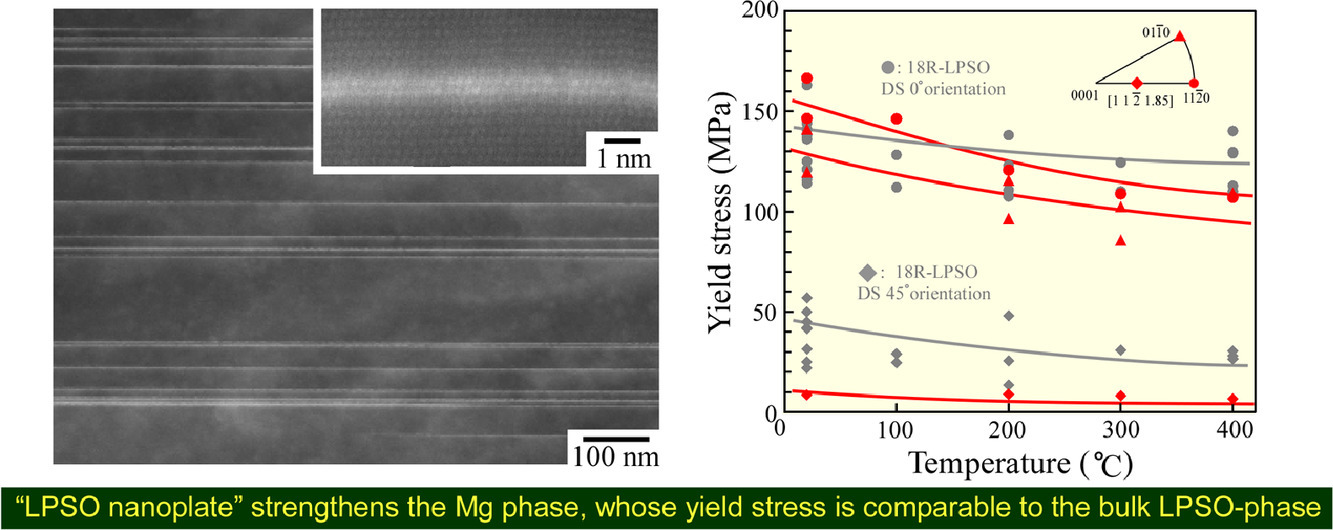
ACTA
Vol. 209,1 May. 2021, 116806
9. A critical relative density and a break-and-reconnect model for annealing-induced densification in nanoporous gold
納米多孔金退火致密化的臨界相對密度和斷裂-重連模型
Hui Xie, Huai Guan, Ling-Zhi Liu, Hai-Jun Jin?
H.-J. Jin:hjjin@imr.ac.cn(中科院金屬所)
https://doi.org/10.1016/j.actamat.2021.116806
摘要
一般認為,用脫合金方法制備的單晶或粗晶納米多孔金(NanoPorous Gold,NPG)在退火過程中是穩定的,不受燒結或致密化的影響。我們研究發現,這種現象僅適用于相對密度(φ)超過臨界值0.31的高密度NPG,在密度在退火過程的變化不顯著。而在φ < 0.31的低密度NPG中,退火引起收縮,且收縮程度隨φ的減小而增大。晶界燒結可以解釋高密度NPG致密度的略微增加,但不能解釋低密度NPG的過度收縮。對于φ< 0.3的低密度NPG而言,致密度的增加可能與多孔金中的連接帶斷裂有關。然而,連接帶斷裂并不直接導致材料的致密化。相反,我們認為連接帶的再附著才是NPG收縮的原因。這種斷裂-重連得到了準原位SEM觀察等實驗的證實。以上研究結果表明,將納米多孔金屬的相對密度提高到0.31以上可以有效抑制退火引起的致密化,這對其組織和性能調控具有重要意義。
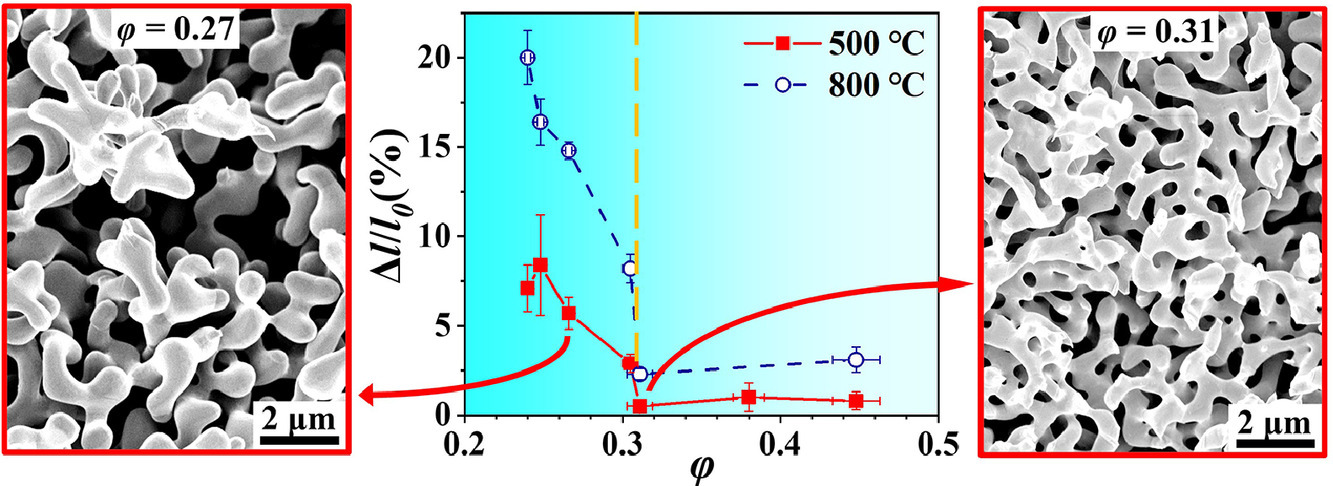
ACTA
Vol. 209,1 May. 2021, 116799
10. The effect of hydrogen content and yield strength on the distribution of hydrogen in steel: a diffusion coupled micromechanical FEM study
基于擴散耦合微觀力學有限元模型研究氫含量和屈服強度對鋼中氫分布的影響
Abdelrahman Hussein?, Alfons H.M. Krom, Poulumi Dey, Gagus K. Sunnardianto, Othonas A. Moultos, Carey L. Walters?
A. Hussein:a.h.a.hussein@tudelft.nl
C.L. Walters:c.l.walters@tudelft.nl
https://doi.org/10.1016/j.actamat.2021.116799
摘要
在本研究中,我們基于擴散耦合晶體塑性模型研究了晶粒各向異性引起的非均勻微觀應力場對氫分布的影響。我們采用具有周期邊界條件的代表性體積單元模擬組織,研究了拉伸載荷、初始氫含量和屈服強度對晶格中H和位錯捕獲H再分布的影響。研究發現,非均勻的微觀應力場導致H在晶界處發生偏聚。這表明除了眾所周知的晶界捕獲外,非均勻應力和塑性應變的相互作用也會促進氫在晶界的積累。材料的屈服強度較高時,由于塑性變形較弱,因此位錯捕獲的H減少。另一方面,較高的靜應力也促進了晶格中H從壓縮區向拉伸區的擴散,這些晶格H增加的區域被認為是潛在的損傷萌發區。這與高強度鋼比低強度鋼更易受氫脆影響的實驗結果一致。
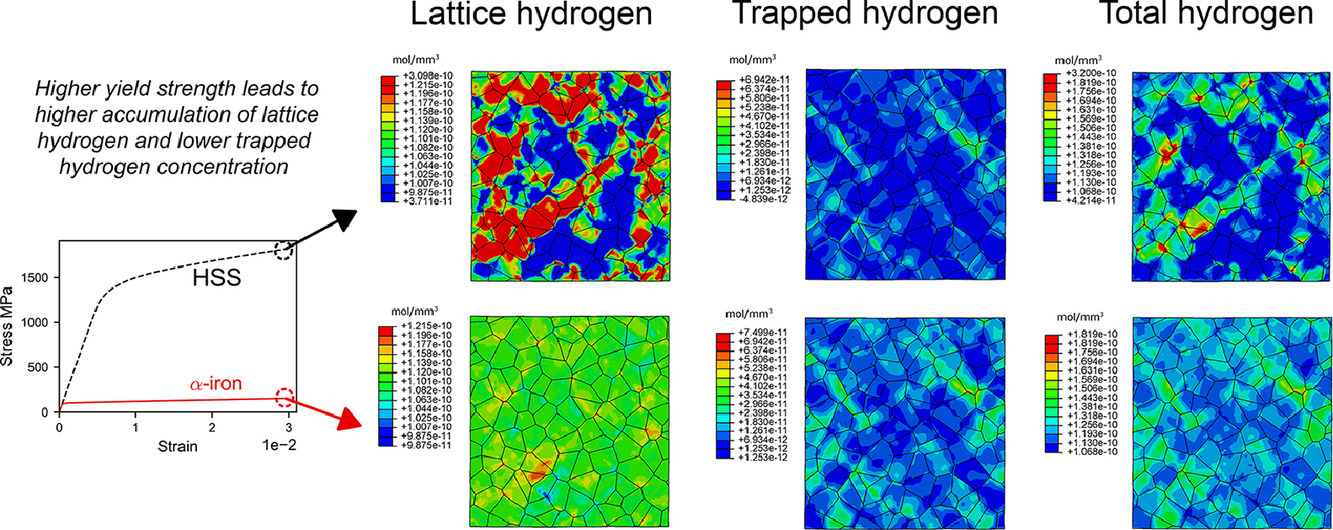
ACTA
Vol. 209,1 May. 2021, 116796
11. Synchrotron X-ray imaging and ultrafast tomography in situ study of the fragmentation and growth dynamics of dendritic microstructures in solidification under ultrasound
超聲凝固過程中枝晶破碎和長大動力學的原位同步X射線成像和超快斷層掃描研究
Zhiguo Zhang, Chuangnan Wang, Billy Koe, Christian M. Schlepütz, Sarah Irvine, Jiawei Mi?
J. Mi:J.Mi@hull.ac.uk
https://doi.org/10.1016/j.actamat.2021.116796
摘要
我們利用高速同步X射線成像和超快斷層掃描技術,原位實時研究了Al-15%Cu合金凝固過程中枝晶組織的破碎和生長動力學。我們在合金熔體中應用30kHz、振幅為29µm的超聲,產生了~0.3 m/s的強渦旋聲流。振動引起了枝晶的高效破碎,其主要機制是熱擾動重熔加上機械斷裂和分離效應。聲流疲勞沖擊和碰撞效應在枝晶破碎中起次要作用。與未超聲條件相比,凝固早期僅應用超聲波10 s,枝晶碎片的數量就增加了約100%,從而使凝固樣品的平均晶粒尺寸減小了20~25%。初始枝晶碎片的數密度及分布主要影響枝晶形態和尖端生長速度。本研究中獲得的系統和實時數據為相關數值模型提供了有價值的4D信息,對工業化超聲熔體加工的工藝優化具有指導意義。
